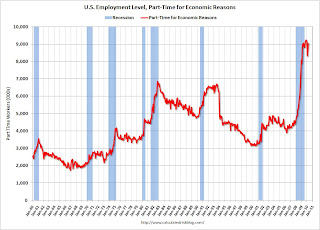by Calculated Risk on 4/02/2010 10:12:00 AM
Friday, April 02, 2010
Employment-Population Ratio, Part Time Workers, Unemployed over 26 Weeks
Here are a few more graphs based on the employment report ...
Employment-Population Ratio
The Employment-Population ratio ticked up slightly to 58.6% in March, after plunging since the start of the recession. This is about the same level as in 1983. Click on graph for larger image in new window.
Click on graph for larger image in new window.
This graph shows the employment-population ratio; this is the ratio of employed Americans to the adult population.
Note: the graph doesn't start at zero to better show the change.
The general upward trend from the early '60s was mostly due to women entering the workforce.
The Labor Force Participation Rate increased slightly to 64.9% (the percentage of the working age population in the labor force). This is at the level of the early 80s. Many of these people will return to the labor force when the employment picture improves - and that will keep the unemployment rate elevated unless net hiring picks up dramatically.
Part Time for Economic Reasons  From the BLS report:
From the BLS report:
The number of persons working part time for economic reasons (sometimes re-The number of workers only able to find part time jobs (or have had their hours cut for economic reasons) increased sharply to 9.1 million.
ferred to as involuntary part-time workers) increased to 9.1 million in March.
These individuals were working part time because their hours had been cut back
or because they were unable to find a full-time job.
The all time record of 9.2 million was set in October. This suggests the increase last month was not weather related - and is not a good sign.
Unemployed over 26 Weeks
 The blue line is the number of workers unemployed for 27 weeks or more. The red line is the same data as a percent of the civilian workforce.
The blue line is the number of workers unemployed for 27 weeks or more. The red line is the same data as a percent of the civilian workforce.According to the BLS, there are a record 6.55 million workers who have been unemployed for more than 26 weeks (and still want a job). This is a record 4.3% of the civilian workforce. (note: records started in 1948)
The number of long term unemployed is one of the key stories of this recession.
Although the headline number of 162,000 payroll jobs was a positive (this is 114,000 after adjusting for Census 2010 hires), the underlying details were mixed. The positives: the unemployment rate was steady, the employment-population ratio ticked up slightly (after plunging sharply), and average hours increased (might have been impacted by the snow in February).
But a near record number of part time workers (for economic reasons), a record number of unemployed for more than 26 weeks, and a decline in average hourly wages are all negatives.
I'll have even more later ...
Earlier employment post today:


